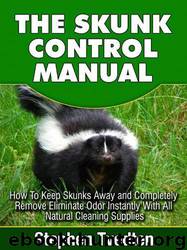The Skunk Control Manual: How to Keep Skunks Away and Completely Eliminate Odor Instantly With All Natural Cleaning Supplies by Stephen Tvedten

Author:Stephen Tvedten
Language: eng
Format: mobi
Publisher: Pest Management Group
Published: 2013-04-25T06:00:00+00:00
TRAPPING SKUNKS
Lethal traps - Conibear and leghold traps - Since a skunk infestation beneath or around buildings normally involves only a few skunks, trapping is often the control method of choice. Skunks are relatively easy to trap if you place a 160-size Conibear trap over the den opening, these traps have a square frame with two rotating jaws. Larger versions typically have two springs. These traps are designed to strike small to medium- sized animals (including pets) in the neck or body and kill them quickly. If these cruel traps were judged by the agony they inflict - their use would never be justified. Leghold traps and/or shooting are not recommended methods to dispose of skunks, as they often result in the release of a terrible odor.
Live traps -Havahart®, www.havahart.com/nuisance/cagetrap_quickguide.asp and Tomahawk® www.tomahawklivetrap.com/products/31.html are appropriate means of capturing and removing living skunks. These live raps should be baited with foods, e.g., fish(canned, smoked or fresh), honey, mayonnaise, eggs, fish-flavored cat food, chicken entrails or parts, greasy chicken bones, bacon, or peanut butter on bread. Bait the covered live trap and set the trap in the trail immediately in front of the burrow’s main entrance. Logs, twigs, brush or stones can be placed on either side of a path between the burrow opening and the trap will aid in funneling the skunk toward the trap. All traps should be visually checked in the morning and early evening every day. You may not be able to legally release trapped skunks in your area, so check with your local officials first. When setting live traps for skunks, be certain the trapped animal will not be disturbed by dogs after being caught. This will keep them from spraying their musk.
When approaching a live trap, move slowly and talk calmly so as not to startle the skunk. Slowly cover the trap with dark sack, cloth or place it in a black plastic sheet or bag. When getting close to some skunks, you may notice an odor because their musk lingers for some time after each discharge. This does not mean the skunk has just released or is about to release its ill-smelling stench. Check to see if it is legal before releasing them. (Would you REALLY want skunks released in your yard?)
Before setting the live trap, carefully cover sides and bottom of the trap with wood or burlap so the skunk will not spray and will not be able to dig the trap full of dirt. If you use boards rather than burlap, cut two small holes in the side boards so you can look in. Carefully place the trap so the “blind side” is the way you must go to get the trap. The caught skunk will leave the trap on its own if you place it near low shrubbery and open the door. You can also shake him out (be sure you hold on to the bar that locks the door) over a bridge or small embankment so that when he gets up you are out of range or not in view.
Download
This site does not store any files on its server. We only index and link to content provided by other sites. Please contact the content providers to delete copyright contents if any and email us, we'll remove relevant links or contents immediately.
The Body: A Guide for Occupants by Bill Bryson(4974)
Audition by Ryu Murakami(4850)
Adulting by Kelly Williams Brown(4487)
Housekeeping by Marilynne Robinson(4346)
Be in a Treehouse by Pete Nelson(3945)
Zero Waste Home by Bea Johnson(3777)
Seriously... I'm Kidding by Ellen DeGeneres(3577)
Better Homes and Gardens New Cookbook by Better Homes & Gardens(3525)
The Healing Self by Deepak Chopra(3474)
Barkskins by Annie Proulx(3312)
Hedgerow by John Wright(3275)
The Cellar by Natasha Preston(3260)
Spark Joy by Marie Kondo(3249)
The Genius of Japanese Carpentry by Azby Brown(3224)
The Life-Changing Magic Of Tidying Up- The Japanese Art Of Decluttering And Organizing (v5.0) by Marie Kondo(3211)
120 Days of Sodom by Marquis de Sade(3179)
Work Clean by Dan Charnas(3048)
The Book of Numbers by Peter Bentley(2912)
A Monk's Guide to a Clean House and Mind by Shoukei Matsumoto(2868)
